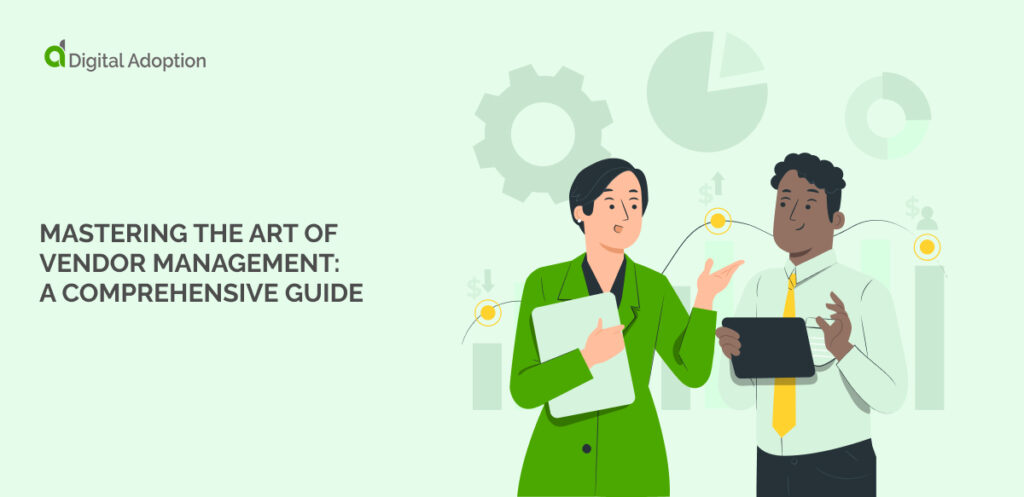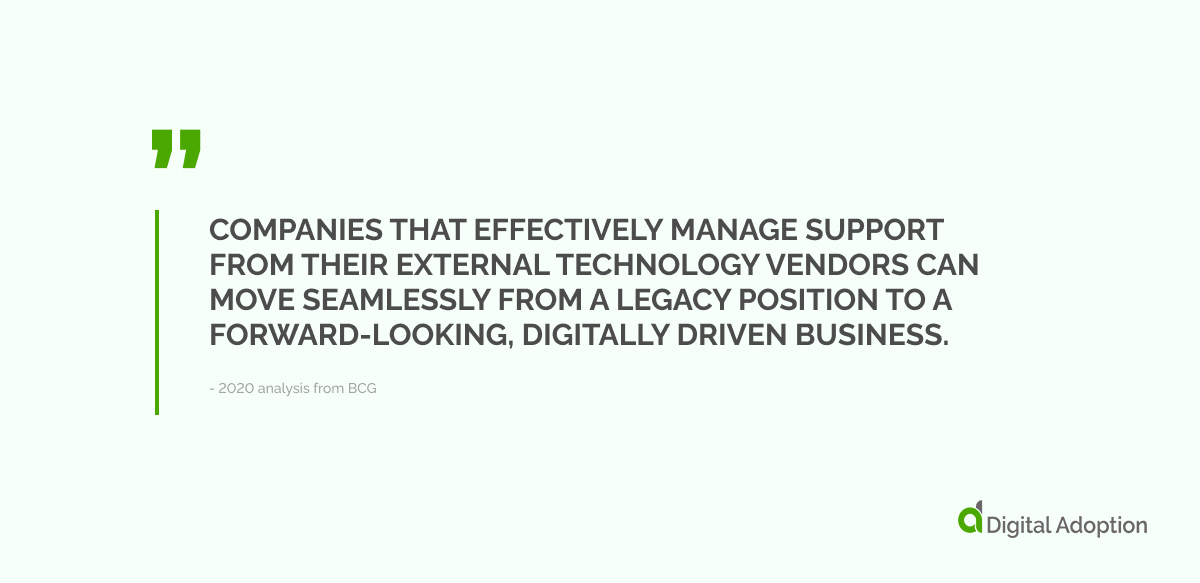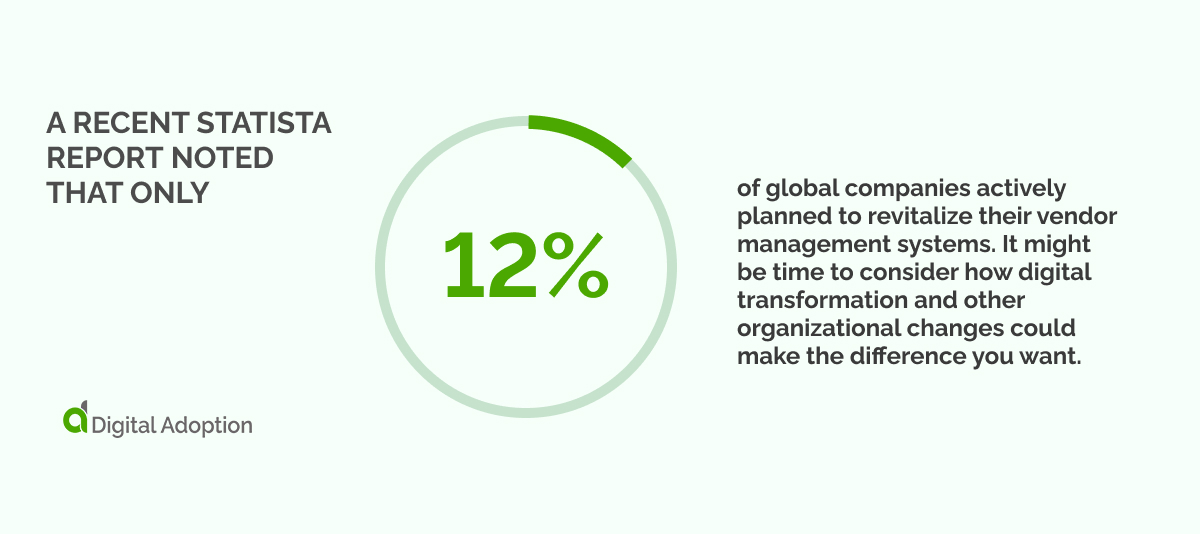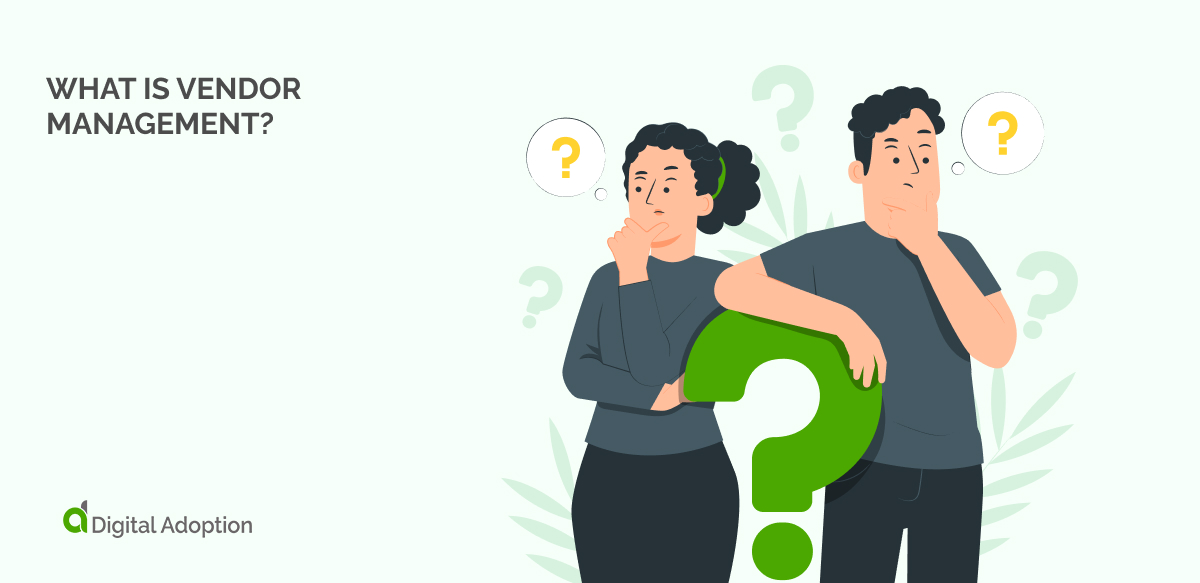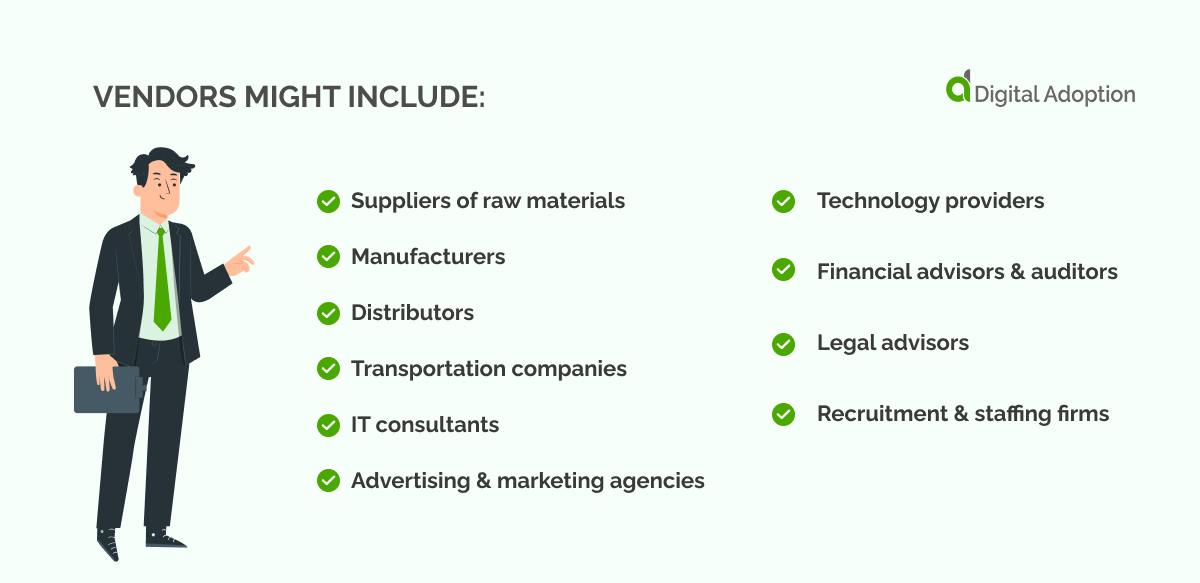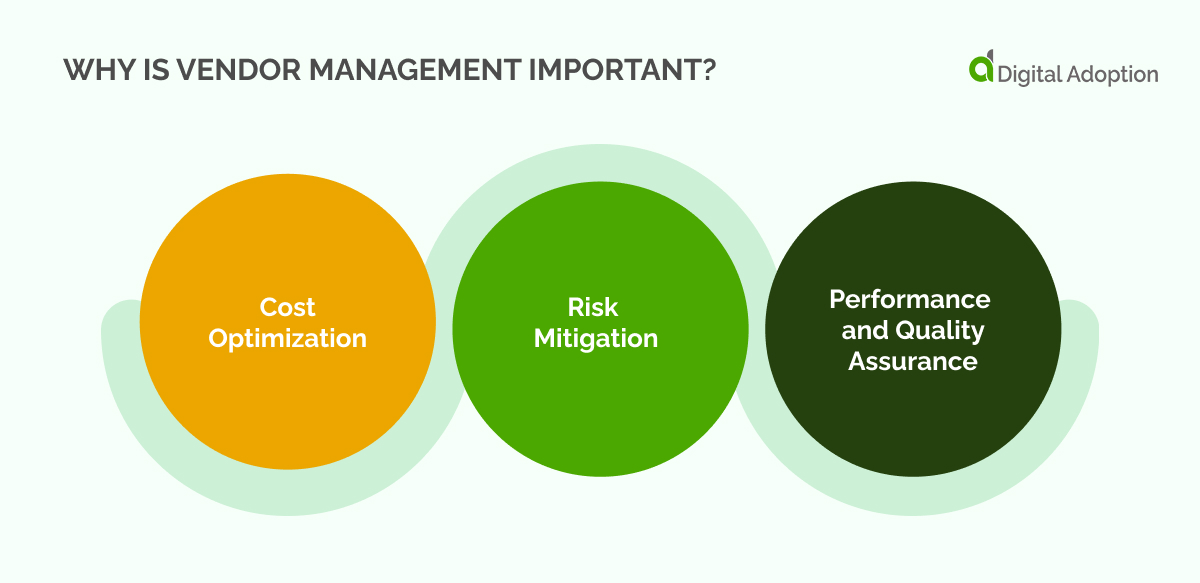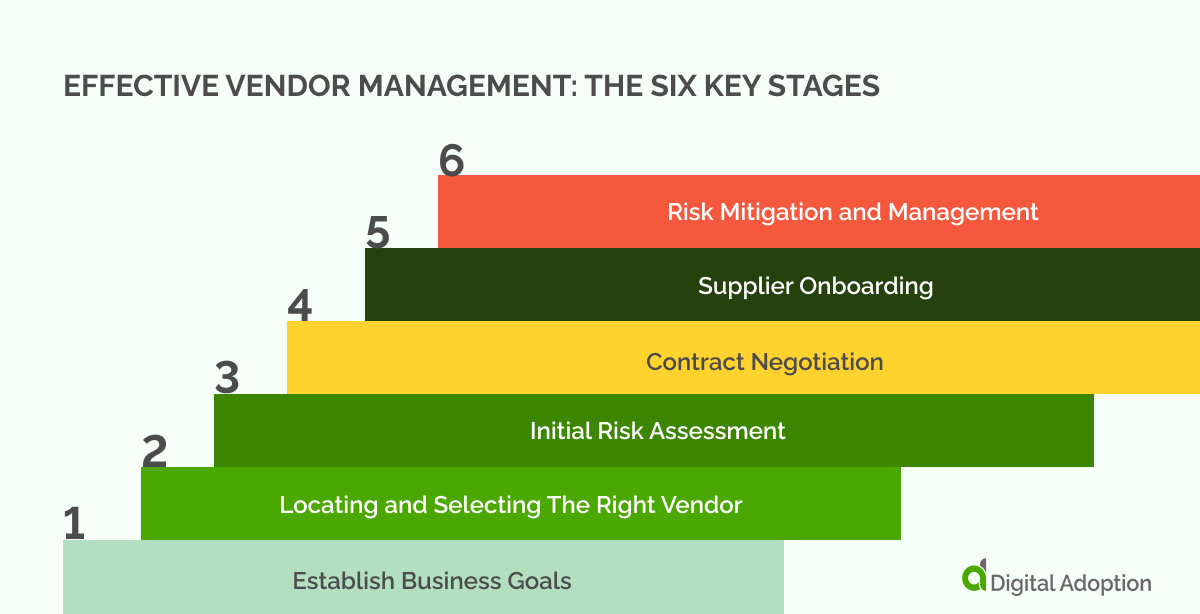Do all businesses have difficulty establishing strong relationships with their vendors?
It’s now common for companies to work with multiple vendors, each of which has its strengths, weaknesses, and ongoing needs. It’s difficult for each member of staff to keep up.
If that sounds like you, it’s time to get to grips with your vendor management strategies. When business leaders know what vendor management is – and how to do it! – you can expect to develop mutually beneficial relationships with your third-party providers.
This article will explain why vendor management is worth investing time and money in. It will also define vendor management, how it can help save a company money, and how to implement a strategic process to ensure a great relationship with each vendor.
Whether or not a company goes through a digital transformation to deal with these issues, an efficient vendor management process is fundamental to sustained growth.
Great relationships with B2B vendors are crucial for the smooth running of any organization. And indeed, these relationships can make major changes in some areas. A 2020 analysis from BCG, for example, shows how vendor relations improve digital transformation projects:
“Companies that effectively manage support from their external technology vendors can move seamlessly from a legacy position to a forward-looking, digitally driven business.”
Yet the implementation of vendor management systems is not always a priority. A recent Statista report noted that only 12% of global companies actively planned to revitalize their vendor management systems. It might be time to consider how digital transformation and other organizational changes could make the difference you want.
What is vendor management?
A single business can rarely solve all the challenges of producing and distributing goods themselves. That’s why they need vendors to help achieve their business goals.
Vendors might include:
- Suppliers of raw materials
- Manufacturers
- Distributors
- Transportation companies
- IT consultants
- Advertising & marketing agencies
- Technology providers
- Financial advisors & auditors
- Legal advisors
- Recruitment & staffing firms
Vendor management is managing and overseeing vendors that provide products or services to a business, organization, or individual. At its simplest, the goal of vendor management is to keep the business running as effectively as possible. But at a higher level, vendor management is acquiring maximum benefits from all B2B contracts.
Typically, vendor management will involve creating policies, procedures, and strategies for managing relationships with those vendors. It can include selecting vendors, negotiating contracts, monitoring performance, and evaluating services or products. The goal is always to ensure that they are meeting the company’s needs in an effective and efficient manner while also maintaining quality standards.
Effective vendor management can improve every interaction between a company and its vendors. That might include update meetings, informal conversations, and shared reports. However, good vendor management relies on acquiring robust vendor data. A vendor management system (or VMS) ensures businesses are making excellent decisions around vendors.
Why is vendor management important?
In the smallest companies, managing vendors on an ad hoc basis may be possible. But as a business grows, it’s essential to have a thorough and consistent approach to managing vendors. Three areas that will benefit from effective vendor management are cost optimization, risk mitigation, and quality assurance – which we will now introduce in turn.
- Cost Optimization. Effective vendor management can contribute to cost optimization and savings for a company. Organizations can negotiate favorable pricing, terms, and discounts by managing vendor relationships strategically. It helps ensure the company gets the best value for the goods or services procured. Additionally, vendor management enables the identification of cost-effective alternatives and the consolidation of vendor contracts, leading to streamlined processes and reduced expenses.
- Risk Mitigation. Vendor management plays a crucial role in mitigating risks associated with third-party relationships. Vendors are often responsible for critical aspects of a company’s operations, and any disruption or failure on their part can significantly impact business continuity. Through vendor management practices, companies can assess vendors’ financial stability, reliability, and compliance. This assessment helps identify potential risks, implement risk mitigation strategies, and establish contingency plans to minimize disruptions, maintain quality, and protect the company’s reputation.
- Performance and Quality Assurance. Effective vendor management focuses on ensuring that vendors meet performance and quality expectations. Regular monitoring, evaluation, and performance reviews enable companies to assess vendor performance against predetermined metrics and standards. This process helps identify areas for improvement, address any issues proactively, and maintain consistent quality throughout the supply chain. By holding vendors accountable for their performance, companies can deliver better products or services, enhance customer satisfaction, and drive business growth.
Vendor management is an essential part of running a successful business. It enables companies to negotiate the best terms and prices for their goods or services, reduce risk associated with third-party relationships, and ensure quality performance from vendors. Good vendor management also promotes collaboration between companies and vendors, leading to long-term success for all parties involved.
Effective vendor management: the six key stages
For effective vendor management, you must pay attention to every stage of the vendor relationship. Remember, a poor management process can cost a company money: and there are opportunities for efficiencies and savings at every step of the journey. From initial procurement to offboarding, an active approach with the right vendors can help directly to fulfill business objectives.
1. Establish Business Goals
The first step of vendor management is to understand the current needs of your business. This is important for every other process you take.
In this step, the team will eventually decide what solution they are looking for. That might be a new cloud ERP, an outsourced helpdesk, or a new supplier of hand soap for the bathrooms.
But this step is also a time to remember the business’s core purpose. Is it to deliver excellent value retail products, best-in-field digital solutions, or to ensure a harmonious workplace? If a company knows what goals they are addressing in a particular project, all the specifics will be easier to decide.
2. Locating and Selecting The Right Vendor
Some niche services are so specialized that there will be very few vendors.
However, a business will have many suitable options for a new vendor in most areas.
With clear business goals, it’s much easier to determine vendor selection criteria. From there, the project team can undertake market research, shortlist vendors who meet their needs, and request proposals from the most appropriate ones.
It’s not always easy to see which is the most appropriate candidate. Evaluating proposals on a points system can often bring clarity to the process.
3. Initial Risk Assessment
Having made a choice, it’s time to subject the selected vendors to a full risk assessment.
Some aspects of the assessment will be outside the selected vendor’s control. Problems like price instability, supply chain disruption, and inaccurate market forecasts may similarly impact all players in a particular field. A vendor can still explain what they are doing to control problems in their work sphere.
Other parts of the assessment will address the project and the vendor. Have they performed adequately in the past? Is their sourcing of labor and materials ethical? Could there be problems with overspending?
In this complex area, you can ask a risk mitigation consultant to understand how to minimize these problems.
4. Contract Negotiation
Contract negotiation could impact a project’s costs and may also change the services the vendor provides. After all, negotiation is all about give and take. And Customers who already understand their business goals will be able to adapt to the vendor’s needs. For negotiators, empathy, clear communication, and rapport-building skills are more important than sticking to a hard line.
By this point, both sides have already invested a lot of resources in the process. So it’s in everyone’s interests to work things out for the benefit of both parties.
5. Supplier Onboarding
Onboarding for vendors is an essential administrative procedure. During onboarding, the client company will receive full information about the supplier. Depending on the industry, this may include insurance certificates, bank account details, compliance information, and clear contacts.
It’s common to leave this information out of the tender process. However, if a supplier can’t provide complete documentation at this stage, they may lose the contract.
Businesses should expect the supplier to be helpful and considerate. However, just because they are struggling to get their data, all lined up doesn’t mean that they are necessarily awful to deal with
Digital onboarding, such as an online client portal, can be a valuable way of collecting this data. It is more automated, cost-effective, and reliable than sending information by mail, email, or fax.
6. Risk Mitigation and Management
Once the vendor is on board, the risk assessment will operate more continually. As the relationship develops, the risks associated with the vendor will change. As long as the relationship lasts, you must sustain an up-to-date understanding of risks. Recent Gartner analysis suggests that quarterly scorecards and annual risk assessments are the minimum.
Collaborate for Successful Vendor Management
In this article, we’ve emphasized the changes that a client can make to improve their vendor relations. But although the stages of vendor management have stayed the same in recent years, research shows that a spirit of collaboration is far more effective. A recent article from McKinsey showed that collaborative supplier relations could improve growth, reduce operating costs, and raise profits.
However, if you don’t understand the basics of vendor management, you won’t be able to collaborate effectively. Just remember what we’ve said in this article. Plan carefully before approaching a vendor, create clear contracts and documents, negotiate with care and respect, check their onboarding process thoroughly, and maintain an up-to-date risk assessment.
By following these steps, you can ensure that your project meets its goals and maintains good relationships with vendors over the long term.

